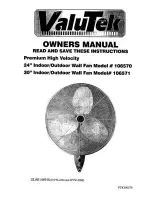
10
WARNING
MAKE SURE THE POWER IS OFF AT THE ELECTRICAL PANEL BOX
BEFORE YOU ATTEMPY ANY REPAIRS. REFER TO THE SECTION,
“MAKING ELECTRICAL CONNECTIONS”.
Because of the fan’s natural movement, some
connections may become loose. Check the all
guards and protective devices are securely in
place and all visible screws are tightened twice
a year. Make sure they are secure.
Cleaning your fan periodically to help maintain
its new appearance over the years, follow the
sectioned “Disassembling Your Fan” for
properly disassembling and cleaning. Do not
use water when cleaning, this could damage
the motor, or possibly cause an electrical
shock. Use only a soft brush or lint-free cloth to
avoid scratches the finish. The plating is sealed
with a lacquer to minimize discoloration or
tarnishing.
You can apply a soft damp cloth to clean the
aluminum blades and front guard, taking care
not to alter the angle of the blades.
There is no need to oil your fan. The motor has
permanently lubricated sealed ball bearings.
1.
2.
3.
4.
Here are some suggestions to help you maintain
your fan.
Check main and branch circuit fuses or breakers.
Check line wire connections to the fan.
Check to make sure the dip switches from the transmitter and receiver
are set to the same frequency.
Make sure all screws on fan motor assembly and fan guards are snug.
Make sure the blade and the blade cover are securely in place.
Allow a 24-hour “breaking-in” period. Most noises associated with a
new fan disappear during this time.
Make sure there is a short distance from the ceiling to the canopy. It
should not touch the ceiling.
Make sure your ceiling box is secure and rubber isolator pads are used
between mounting bracket and outlet box.
Do not connect the fan with a wall mounted variable speed control(s).
Make sure the dip switches are set correctly.
1.
2.
3.
1.
2.
3.
4.
5.
1.
2.
Fan will not start
Fan sounds noisy
Remote control
Care of Your Fan Troubleshooting
PROBLEM SOLUTION

































